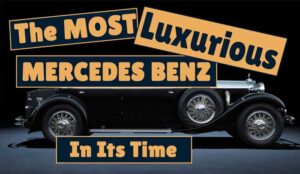The need for speed and faster cars had always been some sort of stimulant for the automobile industry, and if you want to talk about some classic Mercedes sports cars, the Mercedes-Benz S-Series will be a good place to start. If you think I’m kidding, let’s have a look at it, and then you’ll be the judge of that.
A race-oriented version of Daimler’s Type 630 luxury car was built with a revamped chassis called the Model K in the lead up to the merger between Daimler and Benz & Cie. The new Daimler-Benz company wanted to build an even more sophisticated sports car that would be called the Model S (S for Sport) based on the best characteristics of the Model K. This idea gave birth to what we know as The Mercedes-Benz S-Series. The Mercedes-Benz S-Series (W06) was a popular line of sports cars known as the “white elephants from 1927 until 1933. I’m guessing you’re thinking why sports cars would be named “white elephants, well, I thought about it too, but these cars were gold standard back in the day.
The Mercedes-Benz S Series came in four eye-catching models, and we’ll be looking at them one after the other.
Model S
Let’s begin with the Model S. To raise the engine displacement from 6.3 to 6.7 liters, the six-cylinder engine of type 630 was built into a new engine with the bore extended by 4 mm. A design code of M06 was given to this engine, using the naming system that became popular after the merger. With the supercharger engaged, the new M06 engine increased by 40 horsepower, generating 180 hp.
The Model K chassis dimensions were retained, but the frame was substantially lowered, and the engine was shifted 30 cm backward. As a result, the engine was smaller, and the weight distribution increased, improving reliability and handling.
Model SS
If you saw SS in this model and guessed Super Sport, you were right!! This Model was a new version of the Model S, and it was produced in the middle of 1928, designated as the SS or Super Sport.
The use of a wet cylinder liner allowed the M06 to be further bored out to increase displacement to 7.1 liters, which provided an additional 40-horsepower, meaning the developed SS could produce 200 hp with the supercharger engaged. The SS could reach a top speed of 118 mph, which was two to three times the power of most cars of its era.
Model SSK
Though the S and SS models performed greatly in races regarding speed, they were not as impressive concerning turning ability. So, a new version of the S-Series was created at the end of 1928 to compete in hill climbing. This Model, known as the SSK, which stands for SuperSport Kurz, had a wheelbase shortened to 2950 mm and used the improved SS engine but retained the lower SS model radiator. Its improved handling with a top speed of 119 mph made it the most frightening race car of its day.
Model SSKL
In professional racing, the SSK enjoyed considerable success and was a best-seller. In 1931, a pure racing limited edition version was produced that was not sold via the ordinary sales scheme but was only made available to mainstream competitive racers. This new design was called the SSKL, which stands for SuperSport Kurz Leicht (or Super Sport Short Light).
This was a lightweight variant of the high-performance SSK and the fourth and final Model of the S-Series. Perforations that stretched across the entire frame lowered the total weight by 125 kg. The SSKL attained a top speed of 146 mph with a combination of an incredible 300 hp and an incredibly light body.
The S series enjoyed great success in various competitions for Daimler-Benz, but at the same time, these vehicles, including the SSK, were ideal for daily driving and helped by the fact that the styling of the cars was deemed very attractive. So, it’s safe to say that the S Series conquered both the track and the market.
That’s all for now, folks; if you enjoyed the article, it’d be greatly appreciated if you share it with your friends, and stay tuned for another classic car articles.

![You are currently viewing Mercedes-Benz S-Series [S/ SS/ SSK/ SSKL Models] (1927 – 1933)](https://classicsdude.com/wp-content/uploads/2021/05/series-S-website.jpg)
![Read more about the article Mercedes-Benz W11 [Stuttgart 260, 10/50 PS] – (1929 – 1034)](https://classicsdude.com/wp-content/uploads/2021/05/Mercedes-Benz-W11-website-300x174.jpg)
![Read more about the article Mercedes-Benz W03 – [Typ 12/55 PS / Typ 300] – (1926 – 1930)](https://classicsdude.com/wp-content/uploads/2021/05/W03-website-300x174.jpg)
